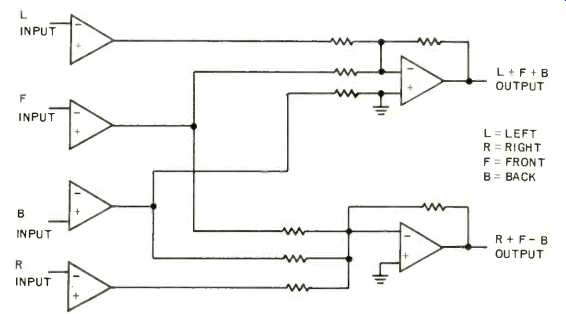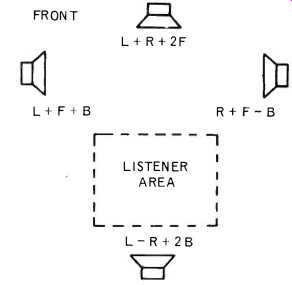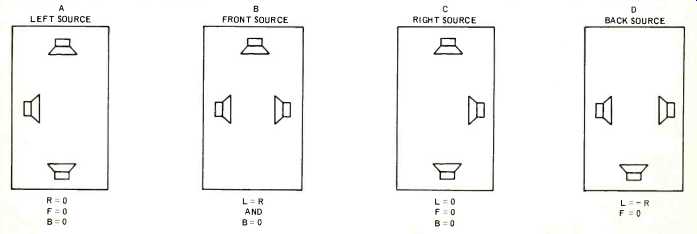by DAVID HAFLER [Dynaco Inc.]
THERE HAS BEEN CONSIDERABLE experimental effort devoted to enhancing sound and music reproduction by using multiple channels. Stereophonic reproduction using two channels was a major step in the direction of using as much information as possible in recording and playback. Two channels give a better impression of the hall characteristics than one channel, and also give increased accuracy of localization of instruments. It is natural to try to extend this to more than two channels in order to obtain even further benefits in these directions.
The general goal in increasing the number' of channels is two-fold:
1) to reproduce ambience of the original concert hall or space in which the recording was made;
2) to obtain specialized sound effects such as positioning the listener in the center of the sounds, or by having sound energy shift from front to back, as well as from left to right.
However, as soon as an attempt is made to utilize more than two channels, the economic problems are increased. More amplifiers and speakers are required, and we come up against certain limitations which are imposed by our recording and reproducing methods. For example, phonograph records can supply two channels with quite good fidelity. In order to obtain additional channels, it would seem necessary to use some multiplexing or switching system which requires far greater bandwidth. This greater bandwidth is difficult to reproduce with present recording and playback methods. If it is based on high-frequency multiplexing, there is great difficulty in getting undistorted high-frequency reproduction outside the normal audio spectrum.
In similar fashion, stereo radio transmissions utilize most of the bandwidth allocated by the FCC. Any attempt to impose additional information either requires revision of the FCC rulings, or limiting bandwidth of the extra channels of information.
Although recording and reproducing systems using four independent channels have been demonstrated to be both possible and effective, cost and incompatibility for all media operate against them.

Fig. 1--Adding Front information In-Phase and Back information Out-of-Phase
to left and right channels.
Fortunately, these systems are still in the embryonic stages, and the industry has made no major commitments to them, since there are other alternatives which can produce the benefits of four-channel sound without the limitations of existing methods and at far lower cost.
A New Multichannel System
Obviously if a system can be derived which can utilize two conventional stereo channels but contain additional information, this system will have large commercial advantage and should make the multichannel system popular for mass markets. This paper describes a simple system for adding additional information into two stereo channels in such a way that multichannel reproduction can be approximated, and the system is compatible with present recording and playback techniques.
This technique is based on adding additional information into the two stereo channels. Straight addition does not require additional bandwidth, and can be done by the most simple summing or mixing networks. The difficulty with such an approach is that the information which has been added cannot be easily extracted and utilized later. Once the information is added, it becomes part of the normal two-channel information, not distinguishable from the other material in these two channels. Fortunately, however, there is a simple technique by which identical information in the two channels can be eliminated. This can be done by direct subtraction of the channels if the information is identical in both phase and amplitude in each channel; and it can be done by addition if the information is equal in amplitude and opposite in phase.
Figure 1 shows a simple block diagram on which this method is based. In the recording process, there are multiple channels of information. Here are shown four specific channels; the left channel, marked "L"; the right channel, marked "R"; the front information, marked "F"; and back information ( from the rear of the hall) marked "B". These signals are combined in such a way that we have available L+F+B and R+F-B.

Fig. 3--Showing a method of using a derived center channel to produce four
channels.
In order to introduce this information into two channels, we must recognize the fact that modern recording techniques use multiple mixing setups. Conventionally now, as many as sixteen channels, some with several microphones, are used. Some are positioned to pick up different segments of the source; and others are positioned pointing toward the rear of the hall to pick up reverberation in order to introduce some of the hall ambience. In our simple block diagram of Fig. 1, the left side information is a composite from several microphones arranged so as to pick up sounds predominantly from the left side of the hall; similarly the right information discriminates in favor of the right side of the hall. Concurrently, there are microphones which favor sound from center of the orchestra or front of the area.
This sound is mixed equally in both left and right channels, and is the "F" information which becomes common to these channels.

Fig. 2--Showing speaker arrangement.
Again, in Fig. 1, there is information labeled "B" which represents back information. This is information which is combined from microphones pointing toward the rear of the hall and/or possibly from microphones placed at the rear of the hall and pointing forward. What is picked up in these microphones has a lag time representing the time it takes for sound to travel from front to back of the hall. It is this time lag that gives the hall some of its distinctive audio characteristic.
Part of this back information also contains reflected signals from the rear which are deficient in high frequencies due to absorption of highs; and although these are not normally audible to the listener in the hall, they do contribute to the overall characteristics of the sound as reproduced in that hall. Also, of course, some music utilizes instruments at the rear of the hall.
In Fig. 1 the two output channels, the augmented left and right, contain our left and right information, plus front information which is in phase in both channels, plus back information which is now out of phase in the two channels. A very simple loudspeaker arrangement can be set up to play this information back in a way which uses the additional dimensional information. Figure 2 shows a suggested arrangement. At the front of the listening area, a speaker is connected which is driven by the sum of the two channels. When these are added and played at the front, the "B" portion is cancelled leaving L+R+2F. At the two sides the two individual channels are fed directly, one with L+F+B and the other with R+F-B. At the rear of the listening space, the difference between the two channels is reproduced giving L-R+2B with the "F" signal cancelled.
[ Patent No. 3,417,203, Stereo System with Derived Center Channel. ]
Figure 3 shows an electrical connection which can give these two separate channels and the sum-and-difference signals in the most simple possible hookup. The L + R signal is obtained by using the Dynaco method of deriving a center channel.' That connection gives the sum in the center speaker, without crosstalk, utilizing only a single blending resistor shown as R in the diagram. The speaker in the rear which produces difference information uses a differential connection across the output of the amplifiers. Other systems, of course, can be used such as a phase-inverting transformer to produce the sum signal. However, the system of Fig. 3 is the most simple available means.
This multichannel system is a logical outgrowth of experimentation using a derived center channel in which the center loudspeaker produces the sum of the two channels. The information common to those channels--that which is of identical amplitude and phase in both channels--is the center sound either obtained by a separate directional microphone or from equal pickup in the two side microphones. By adding the two channels, such common sound is emphasized relative to the side signals since it doubles (by algebraic combination). In this expansion of the principle, the system is inverted so as also to produce additional back sound which is emphasized in the rear loudspeaker.
The inversion consists of carrying the extra back information in opposite phase in the two channels and reproducing it through subtraction of the two channels to produce the difference signal in the rear. It is evident that subtraction will eliminate in-phase signals (so no front signals appear in the rear) just as adding of the two channels for the front speaker will cancel the out-of-phase signals up front (so no rear signal appears there). For a listener in the central area both front and rear are producing the same kind of effect each with a derived center channel, but these channels can carry different and non-interacting information simultaneously; thus adding front and rear information to conventional left and right stereophony.
Referring to Figure 2, we see that there are differences in the sounds which come out of the four different speakers depending on the localization of the original sound source and the corresponding microphone position. At the front of the playback area is sound which normally was centered in the orchestra, plus some of the side information. At the rear the signal is predominantly what is obtained from the back microphones, plus some left and right information. At the sides of the hall is the information for left and right signals and some of the front and back information.
Figure 4 indicates how, with proper phasing and mixing of various signal components, the program engineer controls the direction of the sound source. It is always possible to eliminate a specific signal from one of the loudspeakers. For example, a front signal will not appear at the rear or a left signal will not appear on the right. Such elimination will make that particular signal appear in the other three speakers, and will produce an apparent source on the side of the room which has the center one of these speakers. For example, all information which is mixed out of phase in identical amplitude will appear to be in the rear loudspeaker, Fig. 4D. Sounds which are desired to come from the front of the listening area should be introduced into both channels in phase, Fig. 4B. The directional patterns of Fig. 4 can all operate simultaneously with different signals in each direction as desired. One group of instruments can appear at the front with different ones at hack and sides without interaction between them.
Further if we consider a sound at the front of the hall which arrives some milliseconds later at the rear of the hall, that same millisecond delay will be reproduced in this system. After the sound appears at the front loudspeaker, it will follow at the rear speaker with precisely the same delay in the playback system as in the recording area. Therefore, even though the listener is in a smaller room than in which the recording was made, the time delay from front to rear will be the same as in the large hall, thus reproducing the ambient qualities of that hall.

Fig. 4--Program control can eliminate one loudspeaker so as to create an
apparent sound source with desired directionality.
Compatibility
This system is completely compatible with normal two-channel stereophonic reproduction. The L+F+B and R+F-B signals can be played back on normal two-channel systems without disadvantages and without loss of quality. Records and radio broadcasts using this system can be played normally on systems with conventional two-channel stereophonic equipment. Those who want to hook up the additional speakers can get the benefit of front-to-rear differentiation of sounds as well as the normal side-to-side localization that two channels produce. Normal two-channel material, that is that which is not recorded using this system but recorded in conventional stereophonic fashion, can be played very readily on this system.
If monophonic program material is played using the configuration of Fig. 3, the apparent sound source is primarily in the front loudspeaker. There is no sound output from the rear speaker. In fact, the system balance can be established accurately by adjustment for a null in the back speaker with a monophonic source.
However, when conventional two-channel stereo material is played through the configuration of Fig. 3, the front and side speakers give the same sound as any system with derived center channel; but the rear loudspeaker makes an interesting contribution to the quality of the sound.
The rear loudspeaker reproduces the difference information of the two channels.
This represents all the direct stereo information plus the effects of all reflections and reverberation. These effects are normally masked by the direct sound. This mask is removed when using the rear speaker, and the resulting sound has an open, spacious quality which is a far more accurate representation of the original recording area.
For those who wish to experiment with this effect, it is simple to connect a rear loudspeaker from left "high" output to the right "high" output of the amplifier.
If the level is too high, a series resistor can be added. Preferably this speaker should be placed as far behind the listener as possible so there is some delay in hearing of the rear sound. The delay will augment the beneficial effects. In a room where it is not possible to put the speaker to the rear, two such speakers (in series or in parallel depending on the level desired) can be placed at the sides of the listener, and these use the difference information as if they were one speaker.
This utilization of a rear speaker is independent of the use of a front loudspeaker, and can be tried without any other changes in the conventional stereo system.
The use of this one extra loudspeaker can produce as important an effect as the difference between stereophonic and monophonic sound. However, the benefits are somewhat variable since it is dependent on the random effects of recording techniques which were not concerned with control of ambience. When the recording engineer deliberately introduces ambient information, oppositely phased, in the two channels, then a significant improvement in sound reproduction is obtained.
A true extra dimension of spaciousness is obtained, and except for the cost of the loudspeakers, it is obtained at no cost.
Another novel and important effect has been observed in testing this system and analyzing its compatibility for various uses. With headphone listening, the left and right directional information appears to the sides. The front (in phase) information appears (as in general headphone listening) at the forehead or top of the head. However, the back (out of phase) information appears at the back of the head. It is providential that this system gives some degree of differentiation between front and rear as this opens the opportunity to produce four discrete directions of sound with two ear pieces.
Since the discrimination between front and back involves amplitude and phase changes from ear to ear which depend on the shape of head and contour and absorption characteristics of ear passages, corrective networks can be designed to modify the two channels so that the existing front-to-back discrimination of the system with headphones can be expanded to full localization of the direction of sound sources.
Thus it can be seen that there is complete bi-lateral compatibility of monophonic equipment, normal two-channel systems, and this multichannel method.
The person who connects up this multichannel hookup can play any type of source material, getting full benefit of the enhanced channel information without need of additional amplifiers, and without need for changing or reconnecting his audio system.
The recording engineer can make his recordings on the assumption that people will be using this new system, and he can blend ii desired proportions from the different microphones in order to obtain the type of effect which he feels will be most desirable for the listener. It is probable that with classical music of conventional type, most of the recordings will be made to increase the hall ambience effects.
With rock music and other popular forms, it is very likely that the sonic effect desired will be of the listener in the center of the group. With synthesized music derived by electronic techniques, it will be possible to have the sound jumping around from speaker to speaker and surrounding the listener with any type of effect which the composer desires.
A Proposal
It is proposed that recording companies start to use this technique for commercial recordings. This can be done not only with new recordings, but many multiple channel recordings can be re-mixed and re-mastered to give the benefits of this system. Since the recordings will be compatible, there will be no detriment to issuing them with the additional information included. The user will have his own option as to whether to extract the additional dimensional information.
Should commercial recordings be prepared this way, it is completely within present technical capabilities to use some form of compression and/or expansion to augment the directional differences for those rare situations when enhanced directional discrimination is desired. Thus, the proposed system ( which has been tested and demonstrated) provides a compatible framework for more sophisticated techniques should they ever be desired.
The Hafler system will be demonstrated at the Consumer Electronic Show-which, incidentally, is for dealers only. Work is going on behind the scenes with several other systems (Dorren, Quart, etc.) and we will publish full details as they become available. (Ed).
(adapted from Audio magazine, Jul. 1970)
Also see:
How Many Channels? Part I (Nov. 1970)
How Many Channels? Part II (Feb. 1971)
Omnidirectional Radiation (in Acoustics) (Mar. 1973)
Quadraphony Needs Directional Loudspeakers (Mar. 1973)
= = = =